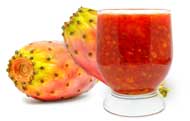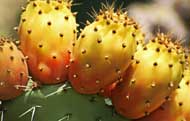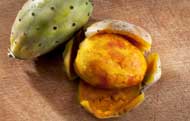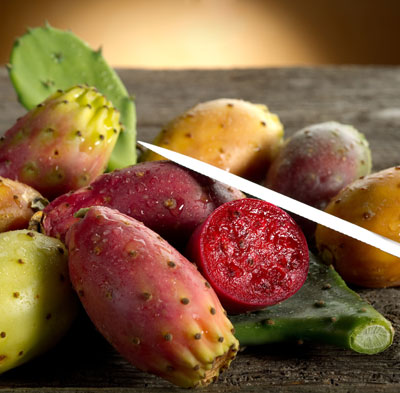





1. Prickly Pear Facts
2. Types of Prickly Pears
3. Nutritional Value of Prickly Pear
4. Health Benefits of Prickly Pear
Prickly pear (Opuntia) is a succulent cactus characterized by flattened, fleshy, and jointed stem segments, or "pads," that are covered in spines and fine, barbed bristles called glochids. Prickly Pear (Opuntia), commonly called the prickly pear cactus, is a genus of flowering plants in the cactus family Cactaceae, many known for their flavourful fruit and showy flowers.
Prickly pear tastes like a subtle cross between watermelon, kiwi, and berry, with a mildly sweet, slightly floral flavour. The texture is soft, juicy, and can be gritty from the small, edible seeds. Some people also compare the flavour to bubblegum, cucumber, or pear. The fruit and leaves are edible. The most common culinary species is the "Barbary fig" (Opuntia ficus-indica).
These plants can grow as shrubs or small trees, have small, scale-like leaves that drop early, and produce colourful, often yellow or orange, flowers. The plant also develops a pear-shaped, bristly fruit that varies in colour from red to purple, orange, yellow, or green.
In places where they have been introduced outside their native range, some species in the genus Opuntia behave as aggressive invasive species.
History and Origin
Prickly pear is native to the Americas, with a history in Australia dating back to its introduction by the First Fleet in 1788 to support a cochineal dye industry. It spread rapidly in Australia, becoming a major agricultural pest until a biological control, the Cactoblastis cactorum moth from South America, was introduced in the 1920s. The plant is now widely distributed across many parts of the world, both natively and as an invasive species.
- • Indian fig prickly pear
While many types of prickly pear have been introduced to Australia, most are classified as invasive weeds and are illegal to sell or propagate. The most common species is the common prickly pear (O𝑝𝑢𝑛𝑡𝑖𝑎 𝑠𝑡𝑟𝑖𝑐𝑡𝑎), and others like tiger pear (O𝑝𝑢𝑛𝑡𝑖𝑎 𝑎𝑢𝑟𝑎𝑛𝑡𝑖𝑎𝑐𝑎) and smooth tree pear (O𝑝𝑢𝑛𝑡𝑖𝑎 𝑚𝑜𝑛𝑎𝑐𝑎𝑛𝑡ℎ𝑎) are also widespread. The Opuntia ficus-indica (Indian fig prickly pear) is the sole exception, as it is permitted under controlled conditions for its agricultural value.
Invasive and prohibited types
Common prickly pear (O𝑝𝑢𝑛𝑡𝑖𝑎 𝑠𝑡𝑟𝑖𝑐𝑡𝑎): The most common and widespread species in Australia.
Tiger pear (O𝑢𝑛𝑡𝑖𝑎 𝑎𝑢𝑟𝑎𝑛𝑡𝑖𝑎𝑐𝑎): Distinguished by its elongated pads.
Smooth tree pear (O𝑝𝑢𝑛𝑡𝑖𝑎 𝑚𝑜𝑛𝑎𝑐𝑎𝑛𝑡ℎ): Known for its yellow flowers.
Wheel cactus (Op𝑢𝑛𝑡𝑖𝑎 𝑟𝑜𝑏𝑢𝑠𝑡𝑎): Also known as wheel-pear.
Velvet prickly-pear (Op𝑢𝑛𝑡𝑖𝑎 𝑡𝑜𝑚𝑒𝑛𝑡𝑜𝑠𝑎): A larger, tree-like species.
Other invasive species: Several other types, like Opuntia\ dillenii and Opuntia\ engelmannii, are also naturalized in Australia.
Permitted type
Indian fig prickly pear (O𝑝𝑢𝑛𝑡𝑖𝑎 𝑓𝑖𝑐𝑢𝑠−𝑖𝑛𝑑𝑖𝑐𝑎): This species is the only one allowed in Australia due to its agricultural uses and less invasive nature.
Important consideration
Weed status: Many prickly pear species are classified as noxious weeds in Australia, and it is illegal to sell, propagate, or swap them in most states.
Identification: If you are unsure about the type of prickly pear you have, it is best to contact your local state herbarium for assistance with identification.
Fruit ” Prickly Pear ” ( Nutritional value )
Nutritional value per 100 g
Prickly pears, raw
|
Nutrient ( Proximate’s )
|
Unit
|
Value
|
Daily Value %
|
|
Energy
|
kcal
|
41
|
2%
|
|
Protein
|
g
|
0.73
|
1.4%
|
|
Total lipid (fat)
|
g
|
0.51
|
0.6%
|
|
Carbohydrate, by difference
|
g
|
9.57
|
3.4%
|
|
Fiber, total dietary
|
g
|
3.6
|
12.8%
|
|
Sugars, total
|
g
|
||
|
Minerals
|
|||
|
Calcium, Ca
|
mg
|
56
|
4.3%
|
|
Iron, Fe
|
mg
|
0.30
|
1.6%
|
|
Magnesium, Mg
|
mg
|
85
|
20.2%
|
|
Phosphorus, P
|
mg
|
24
|
1.9%
|
|
Potassium, K
|
mg
|
220
|
4.6%
|
|
Sodium, Na
|
mg
|
5
|
0.2%
|
|
Zinc, Zn
|
mg
|
0.12
|
1%
|
|
Copper, Cu
|
mg
|
0.080
|
8.8%
|
|
Selenium, Se
|
mcg
|
0.6
|
1%
|
|
Vitamins
|
|||
|
Vitamin C, total ascorbic acid
|
mg
|
14.0
|
15.5%
|
|
Thiamin (B-1)
|
mg
|
0.014
|
1.1%
|
|
Riboflavin (B-2)
|
mg
|
0.060
|
4.6%
|
|
Niacin (B-3)
|
mg
|
0.460
|
2.8%
|
|
Vitamin B-6
|
mg
|
0.060
|
3.5%
|
|
Vitamin B-12
|
mg
|
0.00
|
|
|
Folate DFE (dietary folate) (B-9)
|
mcg
|
6
|
1.5%
|
|
Vitamin A, RAE (retinol)
|
mcg
|
||
|
Lipids
|
|||
|
Saturated Fatty Acids
|
g
|
0.067
|
0.3%
|
|
Monounsaturated Fatty Acids
|
g
|
0.075
|
|
|
Polyunsaturated Fatty Acids
|
g
|
0.213
|
|
|
Trans Fatty Acids
|
g
|
0.000
|
|
|
Carotenoids
|
|||
|
Beta-Carotene
|
mcg
|
25
|
|
|
Beta-Cryptoxanthin
|
mcg
|
3
|
|

|
Reference Values are based on a 2,000 Calorie Intake, for Adults and Children 4 or More Years of Age. Your daily values may be higher or lower depending on your calorie needs.
|
|
Percentages are roughly approximated using (RDA) Recommended Dietary Allowances for adults. Source: Nutrient Database – USDA (United States Department of Agriculture)
|
|
Reference Values for Nutrition – FDA U.S. Food and Drug Administration
|
Prickly Pear Nutritional Value
Prickly pear (Opuntia) offers several health benefits, including its rich nutritional content, high fiber, and antioxidants. It may help manage blood sugar and cholesterol, support digestive health, and provide anti-inflammatory effects. Both the fruit and pads (nopales) are edible and can be incorporated into a diet, but individuals with diabetes should consult a healthcare provider before adding them due to potential blood sugar-lowering effects.
- CHOLESTEROL REDUCTION
Studies show that prickly pear can help reduce cholesterol, specifically lowering total cholesterol and LDL ("bad") cholesterol. It appears to achieve this effect primarily through its high pectin fiber content, which binds to bile acids, leading to increased excretion and a reduction in cholesterol synthesis. This leads to lower plasma cholesterol levels and may also improve LDL particle size, making them less atherogenic. - BLOOD SUGAR MANAGEMENT
Prickly pear may help manage blood sugar due to its high fiber content and other compounds that can slow sugar absorption and potentially increase insulin sensitivity. While studies show promising results for blood sugar reduction in both animal models and humans, it is crucial to consult a doctor before using Opuntia for diabetes management, as more long-term research is needed and it should not be used as a replacement for medical treatment. - SUPPORT HEART HEALTH
Prickly pear may support heart health by helping to lower cholesterol, reduce blood pressure, and reduce oxidative stress due to its fiber, potassium, and antioxidant content. Studies suggest prickly pear can lower LDL ("bad") cholesterol and triglycerides, and some research indicates it may help reduce the impact of exercise on the heart. - ANTIOXIDANT PROTECTION
Prickly pear provides antioxidant protection through its rich content of bioactive compounds like flavonoids, betalains, and polyphenols. These compounds help protect against oxidative stress by scavenging free radicals, preventing damage to cells, and supporting the body's overall antioxidant status.

- GOOD SOURCE OF VITAMINS AND MINERALS
Opuntia, or prickly pear cactus, is a good source of calcium, magnesium, potassium, and phosphorus. It also provides vitamin C and other vitamins such as A, E, K, and B vitamins like riboflavin and niacin. - ANTI-INFLAMMATORY PROPERTIES
Prickly pear has anti-inflammatory properties due to its rich content of antioxidants like flavonoids, phenolic acids, and betanin. Research shows that extracts from Opuntia, particularly Opuntia ficus-indica and Opuntia monacantha, can help reduce inflammation and may offer benefits for conditions like arthritis and pain. The compounds in Opuntia can modulate inflammatory mediators and reduce inflammatory markers. - DIGESTIVE HEALTH
Opuntia (prickly pear) benefits digestive health by providing fiber for regularity, supporting a healthy gut microbiome, and potentially soothing gastrointestinal discomfort. Its high fiber content, including both soluble and insoluble types, helps promote regular bowel movements and prevent constipation. Additionally, it contains nutrients and compounds like betalains and short-chain fatty acids that can help modulate gut bacteria and reduce inflammation in the digestive tract. - HANGOVER RELIEF
Studies show that an extract of Opuntia ficus-indica (prickly pear cactus) can help reduce hangover symptoms, primarily by reducing inflammation. Research indicates it significantly reduces nausea, dry mouth, and loss of appetite, while also decreasing the risk of a severe hangover. The proposed mechanism is that it inhibits the body's inflammatory response to alcohol and its by-products.
References
Nutrient Database – USDA (United States Department of Agriculture)
Reference Values for Nutrition – FDA U.S. Food and Drug Administration
Support heart health - Prickly pear may support heart health by helping to lower cholesterol, reduce blood pressure, and reduce oxidative stress due to its fiber, potassium, and antioxidant content. Studies suggest prickly pear can lower LDL ("bad") cholesterol and triglycerides, and some research indicates it may help reduce the impact of exercise on the heart.
Good source of vitamins and minerals - Opuntia, or prickly pear cactus, is a good source of calcium, magnesium, potassium, and phosphorus. It also provides vitamin C and other vitamins such as A, E, K, and B vitamins like riboflavin and niacin.
High in antioxidants - Opuntia, or prickly pear cactus, is high in antioxidants due to its content of vitamins, polyphenols, and pigments like betalains. These compounds help fight free radicals and mitigate oxidative stress, contributing to its beneficial properties for health.
Blood Sugar Management - Opuntia (prickly pear cactus) may help manage blood sugar due to its high fiber content and other compounds that can slow sugar absorption and potentially increase insulin sensitivity. While studies show promising results for blood sugar reduction in both animal models and humans, it is crucial to consult a doctor before using Opuntia for diabetes management, as more long-term research is needed and it should not be used as a replacement for medical treatment.
Digestive Health - Opuntia (prickly pear) benefits digestive health by providing fiber for regularity, supporting a healthy gut microbiome, and potentially soothing gastrointestinal discomfort. Its high fiber content, including both soluble and insoluble types, helps promote regular bowel movements and prevent constipation. Additionally, it contains nutrients and compounds like betalains and short-chain fatty acids that can help modulate gut bacteria and reduce inflammation in the digestive tract.
Cholesterol Reduction - Studies show that Opuntia (prickly pear cactus) can help reduce cholesterol, specifically lowering total cholesterol and LDL ("bad") cholesterol. It appears to achieve this effect primarily through its high pectin fiber content, which binds to bile acids, leading to increased excretion and a reduction in cholesterol synthesis. This leads to lower plasma cholesterol levels and may also improve LDL particle size, making them less atherogenic.
Anti-inflammatory Properties - Opuntia has anti-inflammatory properties due to its rich content of antioxidants like flavonoids, phenolic acids, and betanin. Research shows that extracts from Opuntia, particularly Opuntia ficus-indica and Opuntia monacantha, can help reduce inflammation and may offer benefits for conditions like arthritis and pain. The compounds in Opuntia can modulate inflammatory mediators and reduce inflammatory markers.
Antioxidant Protection - Opuntia (prickly pear cactus) provides antioxidant protection through its rich content of bioactive compounds like flavonoids, betalains, and polyphenols. These compounds help protect against oxidative stress by scavenging free radicals, preventing damage to cells, and supporting the body's overall antioxidant status.
Hangover Relief - Studies show that an extract of Opuntia ficus-indica (prickly pear cactus) can help reduce hangover symptoms, primarily by reducing inflammation. Research indicates it significantly reduces nausea, dry mouth, and loss of appetite, while also decreasing the risk of a severe hangover. The proposed mechanism is that it inhibits the body's inflammatory response to alcohol and its by-products.
